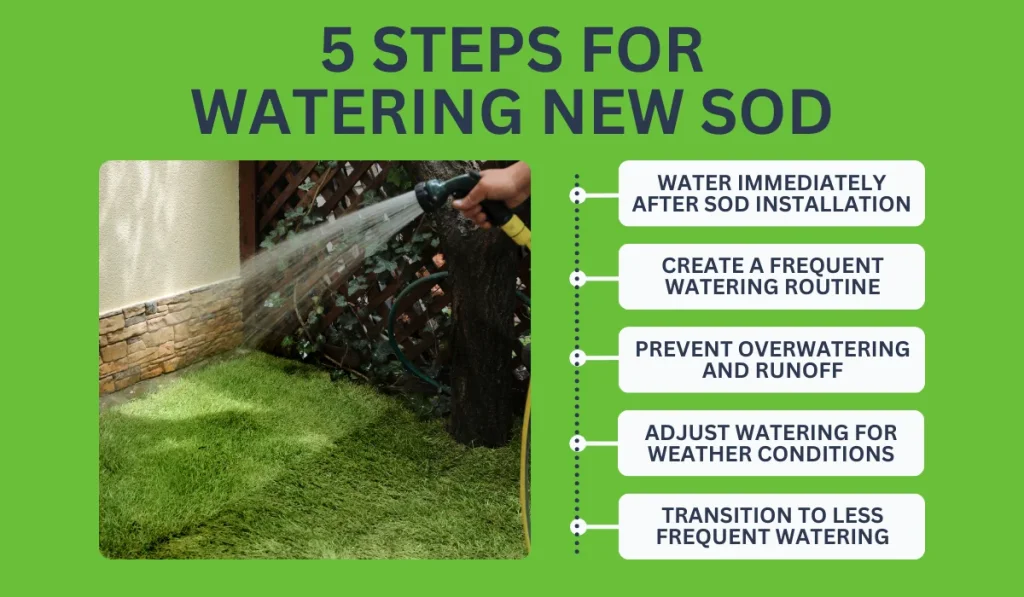Watering new sod properly is one of the most important steps to establish a lush, healthy lawn. Without the right care, sod can dry out, leaving homeowners with brown patches and frustration.
By following a clear watering schedule and understanding your sod’s needs, you can set your new lawn up for success.
Key Takeaways
- Hydrate your sod frequently during the first two weeks to help it establish strong roots and stay healthy.
- Overwatering and runoff can harm your lawn—adjust watering times and tools to keep moisture levels just right.
- Water in the early morning to prevent evaporation and reduce the chance of grass diseases from lingering moisture.
- Once established, your lawn will thrive with less frequent deep watering that encourages resilient, drought-tolerant roots.
5 Steps for Watering New Sod

When sod is first installed, its root system is still shallow and relies heavily on consistent watering to stay hydrated and establish deep roots.
Improper watering for the first time—whether less water or too much water—can lead to problems like overwatering, runoff, or under watering. This hinders root growth and the health of your grass blades.
Follow these steps to keep your sod hydrated and thriving every step of the way:
Step 1: Water Immediately After Sod Installation
Right after installation, it’s crucial to soak the sod and the soil beneath it thoroughly.
This helps settle the sod into the soil and gives the roots immediate access to the moisture they need to start growing. Water deeply enough to reach at least 3” inches into the soil, ensuring the sod is evenly moist without being soggy.
Step 2: Create a Frequent Watering Routine
For the first two weeks, water your sod two to three times per day to keep it consistently moist.
Focus on early morning, mid-morning, and late afternoon watering sessions to prevent the grass from drying out under the hot sun. Aim for consistent moisture across the entire lawn.
Step 3: Prevent Overwatering and Runoff
While consistent moisture is important, overwatering can cause puddles and even drown the roots.
To avoid this, adjust your watering duration based on your soil type and use a sprinkler system to distribute water across the lawn evenly.
If you notice runoff, shorten your watering times and repeat sessions after a short break.
Step 4: Adjust Watering for Weather Conditions
Monitor the weather closely and adapt your schedule accordingly.
During rainy periods, scale back on watering to prevent oversaturation. On the other hand, during particularly hot or dry weather, increase the frequency slightly to keep the sod hydrated and healthy.
Step 5: Transition to Less Frequent Watering
After the first two weeks, reduce your watering sessions to once daily or every other day.
The goal is to encourage deeper root growth by allowing the soil to dry slightly between watering. As roots extend deeper into the soil, the sod becomes more resilient and less dependent on frequent watering.
More Tips for Proper Sod Care
Beyond watering, there are a few other important steps to help your new sod flourish and stay on track for a healthy lawn:
- Choose the Right Tools: Use a sprinkler system or hose with a sprinkler head to ensure even water coverage.
- Water Early in the Morning: This reduces evaporation and minimizes lawn disease risk, as grass blades dry out before evening.
- Monitor Sod Health: Watch for signs of under watering (dry, discolored patches) or overwatering (fast grass growth, soggy areas, or runoff). The first sign of a lack of water is the lawn turning a grey/blue color before turning brown.
- Consider Soil Type: Sandy soils drain quickly and may require more frequent but shorter watering sessions to keep the roots hydrated. In contrast, clay soils hold water longer and benefit from less frequent yet deeper watering sessions.
- Time Your First Mow Carefully: Wait at least 14 days before mowing. Use a sharp mower set to a high blade height to avoid stressing the sod.
Long-Term Maintenance for a Healthy Lawn
Once the sod is fully established, switch to deep watering three times a week or every other day to promote healthy root growth and a more drought-resistant lawn. Continue to monitor for weather changes and adjust your watering schedule as needed throughout the growing season.
With a thoughtful approach and consistent lawn care, watering your new sod doesn’t have to be a challenge.



